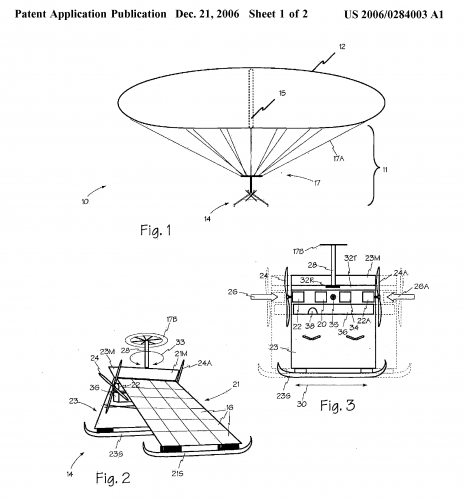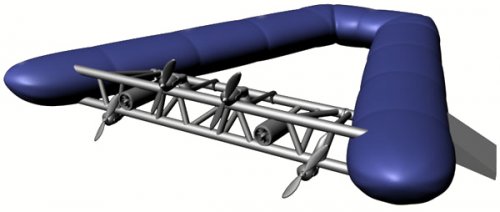HYBRID NEAR-SPACE VEHICLE TAILORED TO FILL MILITARY AND HOMELAND SECURITY “TACTICAL CAPABILITY GAPS” COULD REVOLUTIONIZE THE COMMERCIAL REMOTE- SENSING AND CELLPHONE-COMMUNICATION SECTORS.
CollaborX and Multimax, small companies that joined forces to develop a plat-form dubbed “MaXflyer,” took a different approach to designing a vehicle intended to remain at a 100,000-ft. altitude for several weeks. Rather than design an airship to carry a specified payload weight to those high altitudes, they first defined a con-cept of operations (conops) that met commanders’ needs.
“We wanted to solve the last-tactical-mile’ problem that we experienced in Operation Iraqi Freedom,” says USAF Maj. Gen. (ret.) John W Hawley, CollaborX Inc. founder, president and CEO. “We did a good job of getting information into command centers [during the war], but we still failed to bring needed info down to the soldier, Marine and special operator. So, we view MaXflyer as a tactical near-space platform to provide persistent TSR and communications.” Hawley headed USAF’s Command, Control, Intelligence, Surveillance and Reconnaissance
Center.
MaXflyer is a 220-ft.-dia. circular balloon that lifts a wedge-shaped gondola. But “it’s not a blimp on steroids,” Hawley notes. The balloon assumes an airfoil shape when fully inflated by helium, hydrogen or a mixture of both gases. “It uses the principles of both lighter-than-air and aeronautics, which allows us to fly in a very unique manner,” he explains. “The government tends to categorize these new vehicles as airships, high-altitude UAVs and ‘free-floaters,’ but this is a hybrid.”
The vehicle can maneuver both vertically and horizontally, controlled by a three- axis autopilot . It can be flown from a command center via satcom channels, or through a direct comm link from an in-theater special ops team using a secure, wire -less, laptop computer, for example.
The patented MaXflyer design was “inspired by Navy undersea gliders,” explains Adam Chu, Multimax’s principal investigator. Starting from a desired conops, “We took a systems approach: look at the environment----Mother Nature’s existing forces----then figure out how to work with, not against, them.”
The 100,000-ft. operating altitude “has strategic significance, in terms of sensor coverage. We can cover about 160,000 sq. mi.,” an area about the size of Colorado, says Ron Oholendt, Multimax’s director of local operations here. It also is above today’s fighter aircraft and surface-to-air missile threats, improving the platform’s survivability.
Most near-space vehicles, such as Lockheed Martin’s High Altitude Airship, are designed to operate in the 60,000-70,000-ft. altitude band, where average wind speeds tend to be low. Higher air density at 60,000-ft--—known in near-space circles as the “sweet spot”--—also improves engine efficiency, making it easier to move a huge airship. However, “If you go from 60,000 ft. to 100,000 ft., physics dictates that you more than double the horizon-to-horizon sensor coverage,” Hawley notes. Winds at 100,000 ft. average 20-30 kt., though, and gusts can reach 70-150 kt. “The feature that separates MaXflyer from other near-space concepts is our maneuvering capability,” Oholendt says. “Our unique pitch- and-directional control methods allow us to operate in higher winds.”
All MaXflyer materials and technologies are space-qualified and available commercially, enabling a vehicle to begin tactical operations in about a year—if fund-ing were available today, Hawley says. Balloons will be constructed from Kevlar- based composites and other materials, and each envelope will be tailored to the mission’s planned duration. Longer flights dictate using a thicker materials that tolerate temperature swings and ultraviolet radiation.
“We know the technology to go to near-space is here now. We don’t have to invent anything,” he says . “We designed MaXflyer to a certain capability and made it scalable to meet customer needs—but we didn’t force a payload-weight require-ment on it. That’s what’s driven other near-space concepts and designs to lower operating altitudes and larger vehicles. No single platform will do it all, though,” he cautions. “We’re designing a ‘fighter,’ but the military services also need ‘bombers”’—large, long-duration air-ships designed for strategic missions.
Because it’s tailored to tactical applications, a production MaXflyer—a balloon and gondola fitted with solar panels, batteries, two electric motors and propellers ---- could be fielded for $14.5 million, exclusive of sensors, CollaborX and Multimax officials say. Sensor suites will be tailored to particular applications, such as imaging, communications and intelligence-gathering. A MaXflyer system would he deployed in portable containers transported in-theater by a CH-47 Chinook helicopter. The system would be assembled and launched upwind from its high- altitude operating location. “We have a proprietary design for a launch shelter and a launch technique that protects the balloon during inflation,” Oholendt says. Unlike other balloons, ours isn’t spread out across the ground, so it isn’t subject to the usual risks of damage.” The balloon and its payload gondola will be allowed to “free-float” to high altitude, minimizing the effects of atmospheric turbulence and wind shear . In essence, the launch profile will emulate that of weather balloons that drift with the wind. Once above about 80,000 ft., a MaXflyer’s electric motors and propellers will maneuver the platform into position, then keep it there. “We don’t fight our way up or down, and that mitigates structural stresses, explains G. (Mo) Blackmore, CollaborX’s vice president of technical solutions. “We’ve had a plethora of people tell us we can’t do this, but we’ve solved every problem they’ve raised.” The vehicle also is designed for precision recovery, using an off-the-shelf system “being employed in Iraq today for precision payload delivery,” Hawley says. Lighter-than-air gases wilt be vented overboard and replaced by ambient air to decrease buoyancy, causing the system to descend at a controlled rate.
Production balloon envelopes will be replaced for about $100,000, but the gondota wilt be refurbished with quick-change paytoads and reflown. “With today’s fuel prices, we think we could ‘reballoon’ a MaXflyer for the cost of refueling a big airplane,” he notes.
The next step toward an operational MaXflyer is to build and flight-test a prototype. A strategic partner is needed to underwrite the cost—ideally, a sensor or telecommunications company that sees the MaXflyer as a “dismptive” technology that will spawn a new multibillion-dollar industry. “Communications companies out there have a global vision.. . such as creating third-world nations’ communication infrastructures in hours,” Oholendt says. “Not having to put up cell phone towers can be compelling.”
A platform parked at 100,000 ft. could provide a ready-made emergency cell phone network after natural disasters, like last year’s Katrina and Rita hurricanes that hit the southern U.S. It also could create large-area “WiMax ” broadband wireless “hotspots,” bringing high-speed Internet service to remote regions.
“As soon as this near-space potential is recognized, the market will follow,” Oho-lendt predicts. Despite such rosy projections, big telecommunication, remote- sensing and sensor firms are reluctant to jump on the near-space wagon until a real prototype has flown. Hawley acknowledges that a visionary partner is now needed to jump-start the MaXflyer program and mitigate perceived risks associated with near-space.
“We’re very, very confident this will work,” he stresses. “You get innovation and creativity from small companies, but, unfortunately, ‘the system’ doesn’t always believe small companies can pull off a project like this without help from a bigger brother.”
William B. Scott / Colorado Springs
SOURCE:
AVIATION WEEK & SPACE TECHNOLOGY
January 30, 2006. (Pg. 60-61)





